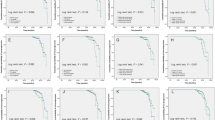Abstract
We examined the eyes of a group of patients entered into and still continuing in a glaucoma suspect study. Over time, some remained unchanged while others developed chronic open-angle glaucoma (COAG). By comparing the data obtained by ultrasonic measurement of the axial length (A) and central corneal thickness (CCT), along with measurement of intra-ocular pressure (IOP) from these patients and normal control subjects, we found no differences. However, by combining these factors in a calculation of eye-wall stress we found a significant difference between the glaucoma suspect and the future glaucomatous eye.
Similar content being viewed by others
References
Chisholm IA, Stead S, Tan L, Melenchuck JW (1980) Prognostic indicators in ocular hypertension. Can J Ophthalmol 7:4–8
Edmund C (1987) Determination of the corneal thickness profile by optical pachometry. Acta Ophthalmol (Copenh) 65:147–152
Ehlers N, Kruse Hansen F (1974) Central corneal thickness in low tension glaucoma. Acta Ophthalmol (Copenh) 52:740–746
Ehlers N, Bramsen T, Sperling S (1975) Applanation tonometry and central corneal thickness. Acta Ophthalmol (Copenh) 53:34–43
Goldmann H, Schmidt T (1957) Über Applanationstonometrie. Ophthalmologia 134:221–242
Kruse Hansen F (1971) A clinical study of the normal human central corneal thickness. Acta Ophthalmol (Copenh) 49:82–89
Kruse Hansen F, Ehlers N (1971) Elevated tonometer readings caused by a thick cornea. Acta Ophthalmol (Copenh) 49:775–778
Martola EL, Baum JL (1968) Central and peripheral corneal thickness. Arch Ophthalmol 79:28–30
Mishima S (1968) Corneal thickness — a review. Surv Ophthalmol 13:57–96
Rock WJ, Drance SM, Morgan RW (1973) Visual field screening in glaucoma. Arch Ophthalmol 89:287–290
Szczudlowski K (1979) Glaucoma hypothesis: application of the law of Laplace. Med Hypotheses 5:481–486
Tomlinson A, Leighton DA (1972) Ocular dimensions in low tension glaucoma. Br J Ophthalmol 56:97–105
Tomlinson A, Phillips CI (1970) Applanation tension and axial length of the eyeball. Br J Ophthalmol 54:548–553
Von Bahr G (1948) Measurements of the thickness of the cornea. Acta Ophthalmol (Copenh) 26:247–266
Yitteberg J, Dohlman CH (1965) Corneal edema and intraocular pressure: II. Clinical results. Arch Ophthalmol 74:477–484
Author information
Authors and Affiliations
Rights and permissions
About this article
Cite this article
Chisholm, I.A., Drance, S.M. & Chauhan, B.C. The glaucoma suspect: Differentiation of the future glaucomatous eye from the non-glaucomatous suspect eye. Graefe's Arch Clin Exp Ophthalmol 227, 17–20 (1989). https://doi.org/10.1007/BF02169818
Received:
Accepted:
Issue Date:
DOI: https://doi.org/10.1007/BF02169818



